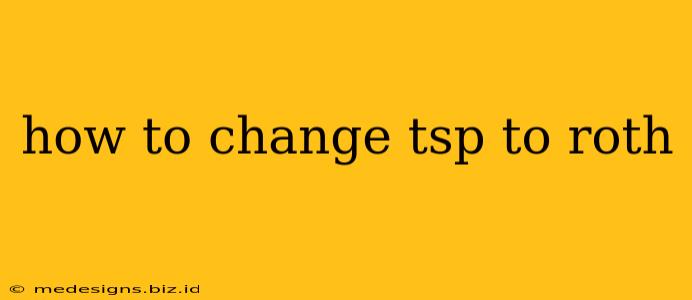Thinking about converting your Traditional TSP (Thrift Savings Plan) to a Roth TSP? It's a big decision, but understanding the implications can help you make the right choice for your retirement. This comprehensive guide will walk you through the process, outlining the benefits, drawbacks, and step-by-step instructions.
Understanding the TSP and Roth TSP Differences
Before diving into the conversion process, let's clarify the key distinctions between Traditional and Roth TSP accounts:
Traditional TSP:
- Contributions: Contributions are made pre-tax, reducing your current taxable income.
- Growth: Your investments grow tax-deferred. You only pay taxes when you withdraw the money in retirement.
- Withdrawals: Withdrawals in retirement are taxed as ordinary income.
Roth TSP:
- Contributions: Contributions are made with after-tax dollars.
- Growth: Your investments grow tax-free.
- Withdrawals: Qualified withdrawals in retirement are tax-free. This includes both your contributions and earnings.
The Benefits of Converting to a Roth TSP
Converting to a Roth TSP offers several significant advantages:
- Tax-Free Withdrawals in Retirement: This is the primary benefit. You won't pay taxes on your withdrawals, meaning more money in your pocket during retirement.
- Tax-Free Growth: Your investments grow tax-free, potentially leading to a larger nest egg compared to a Traditional TSP.
- Potential for Lower Taxes in Retirement: If you anticipate being in a higher tax bracket in retirement than you are now, a Roth TSP can save you significant tax dollars.
The Drawbacks of Converting to a Roth TSP
While the benefits are compelling, there are also drawbacks to consider:
- Paying Taxes Now: You'll have to pay income taxes on the amount you convert from your Traditional TSP to your Roth TSP. This can be a substantial amount depending on your balance.
- Irreversibility: Once you convert, you generally can't reverse the process. This makes careful planning crucial.
- Uncertainty about Future Tax Rates: Predicting future tax rates is difficult. If tax rates decrease significantly in the future, you might have been better off sticking with the Traditional TSP.
How to Change Your TSP to a Roth TSP: A Step-by-Step Guide
The conversion process itself is relatively straightforward:
-
Log into your TSP account: Access your account online through the TSP website.
-
Navigate to the Roth Conversion section: Look for options related to rollovers, transfers, or conversions. The exact wording may vary slightly.
-
Specify the amount to convert: You can choose to convert your entire balance or just a portion of it.
-
Review and confirm: Carefully review all the information before confirming the conversion.
-
Complete the process: Once confirmed, the conversion will be processed by the TSP.
When to Consider a Roth TSP Conversion
The decision of whether to convert hinges on several factors:
- Your current tax bracket: Are you in a lower tax bracket now compared to what you expect in retirement? If so, converting now makes sense.
- Your risk tolerance: The conversion involves paying taxes now, so consider your ability to manage this immediate tax burden.
- Your long-term financial goals: Projecting your retirement needs and income will help determine which TSP best aligns with your goals.
Important Note: This information is for general guidance only. It's crucial to consult with a qualified financial advisor before making any decisions about converting your TSP to a Roth TSP. They can help you assess your individual circumstances and make informed choices based on your specific financial situation. They can also help with tax implications and long-term planning.
Remember to research further and speak with a professional to ensure you're making the best decision for your financial future!
